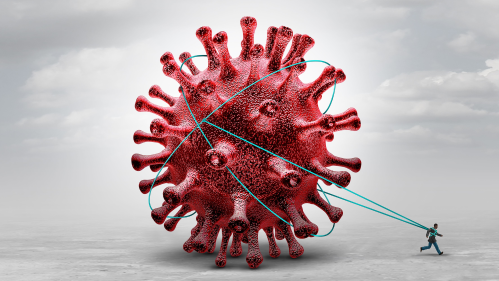As Long COVID Cases Soar, Rutgers Clinic Offers Free Care

Enduring complications from COVID-19 infections have quickly become the third most common neurological disorder, and case numbers continue to rise as new infections create brain fog, fatigue and other serious symptoms.
Patient numbers have likewise grown at the Comprehensive COVID-19 Neurology Care Center of Excellence at Rutgers New Jersey Medical School, which treats patients suffering from long COVID. Although the clinic has seen a rise in demand for services, it’s continuing to recruit new patients with long-term symptoms.
The Newark-based clinic, which was founded by neurology professor Nizar Souayah just months after the pandemic began, draws upon specialists not only from neurology but across the medical school: ear, nose and throat (ENT), rehabilitation, psychiatry, the Rutgers Comprehensive Pain Management Center and more.
The clinic has always been free to patients – it bills insurers for service but asks nothing of those seeking treatment, even if they have no insurers to bill – and is open to all comers.
Souayah explained who may visit the clinic and what they can expect.
What are the most common ongoing neurological symptoms after COVID infection?
Fatigue, headaches, dizziness, numbness, tingling, impaired sense of smell or taste, pain, cognitive impairment, anxiety, depression and others.
What causes these symptoms?
Research is ongoing. It appears that the damage occurs during illness, and the body struggles to repair it after the virus is gone.
Can specialized treatment typically repair the damage?
Unfortunately, no, but it can significantly reduce the burden of many symptoms.
Who should visit the clinic?
Anyone who continues to experience life-altering symptoms for more than four to six months after recovering from COVID, despite seeking treatment from a regular caregiver.
What does a visit to the clinic entail?
We start with a thorough diagnosis based on the symptoms that the patient describes. That may include a neuropsychology test, electrodiagnostic testing that includes a nerve conduction study and needle EMG, an MRI, an ENT exam or any other test that might identify the underlying issue. Ideally, the diagnostics find the specific problem, and that drives treatment.
How can you diagnose COVID-related impairment without having pre-COVID tests for comparison?
We take patient reports at face value. There may be some patients who mistakenly believe they performed or felt better before COVID, but most of the described differences are far too large to be imagined. We have lifelong distance runners who now struggle to climb the stairs and successful executives who now forget anything they don’t write down.
What treatments do you prescribe?
That depends on symptoms and test results. It can be anything from pain medication to physical or cognitive therapy.
What happens when diagnostic tests are inconclusive?
When that happens – and it’s common to have all tests come back normal – we treat symptoms alone. It can take longer to find an effective treatment, but we often do find one.
Do most of your patients eventually get better?
Most of the ones I’ve seen more than a year after their initial visits do show signs of improvement, so there is reason for hope.


